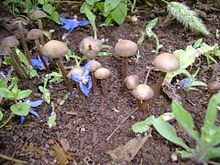Panaeolus bisporus, also known as Copelandia bisporus is a rare and widely distributed little brown mushroom that bruises blue and contains the psychedelic compound psilocybin.
| Panaeolus bisporus | |
|---|---|

| |
| Scientific classification | |
| Domain: | Eukaryota |
| Kingdom: | Fungi |
| Division: | Basidiomycota |
| Class: | Agaricomycetes |
| Order: | Agaricales |
| Family: | Bolbitiaceae |
| Genus: | Panaeolus |
| Species: | P. bisporus
|
| Binomial name | |
| Panaeolus bisporus (Malencon and Bertault) Singer and Weeks
| |
| Synonyms | |
|
Panaeolus bispora | |
| Panaeolus bisporus | |
|---|---|
| Gills on hymenium | |
| Cap is convex | |
| Hymenium is adnexed | |
| Stipe is bare | |
| Spore print is black | |
| Ecology is saprotrophic | |
| Edibility is psychoactive | |
This mushroom is similar macroscopically to Panaeolus tropicalis, Panaeolus cambodginiensis and Panaeolus cyanescens, but can be differentiated using a microscope by its two spored basidia.
Description
editThis is a little brown mushroom that grows on dung and has black spores. It has been found in Hawaii, Southern California, North Africa, Spain and Switzerland.
The cap is 15-30 mm tan to gray fading to black sometimes when covered with spores and with a defined ring zone somewhat globe shaped or bell shaped to convex, hardly expanding, margin often torn and pedaled, smooth not viscid, and slightly wrinkled and pitted with age. Dark grey-brown drying whitish. The gills are adnexed or narrowly attachedtightly packed, mottled gray to jet black, white edges. The stem is white, fibrous, 65-120 mm long 2-3 mm thick, hollow, translucent gray, bruising heavily blue where bruised. It produces spores that are jet black, elliptical, 12-14 x 8-10 x 6-7.5 μm smooth and opaque, elongated with germ pore straight off the end. Microscopic features are 2 spored basidia 18 - 23 × 8-10 μm, cheilocystidia are bottle shaped and clear 20-30 μm, metuloids with yellow brown walls 40-55 × 12-15 μm some with excreted crystals.
Its habitat are saprotrophic on grasses.
See also
editReferences
edit- Stamets, Paul (1996). Psilocybin Mushrooms of the World. Berkeley: Ten Speed Press. ISBN 0-9610798-0-0.